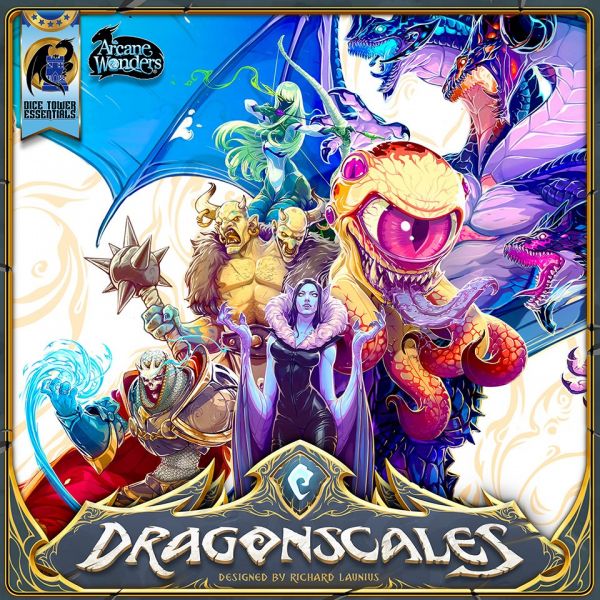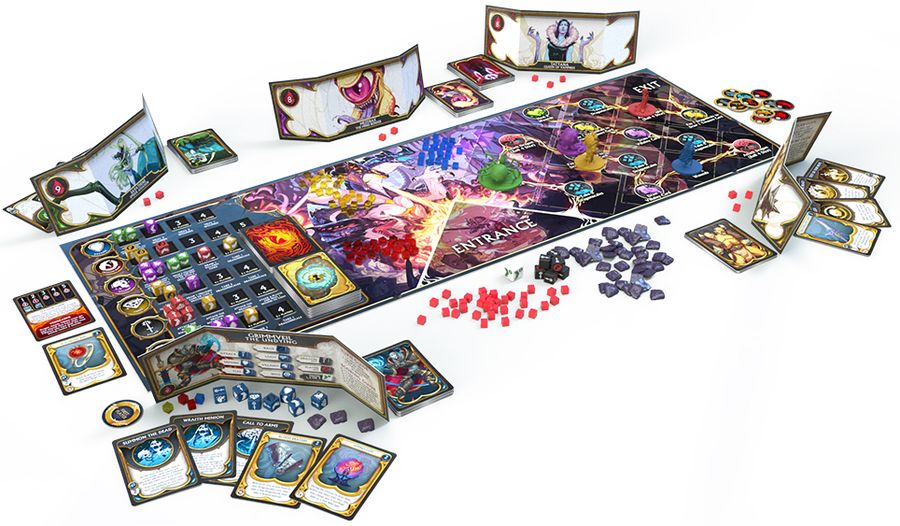Can You Be the Most Powerful Villain and Escape in Dragonscales?

In Dragonscales, you try to collect treasure, become stronger, or escape the three-headed dragon to be the most villainous.
Gameplay
Dragonscales is a 3-5 player game that combines dice rolling, press your luck, and take that mechanics in a game where everyone is a villain that is trying to defeat the three-headed dragon or escape from its lair.
Each player will receive a character shield and a set of Villainy cards, allowing them to take specific actions during various phases of the game. Players will also receive their own set of dice to roll behind their screens. During a round, players will roll their dice up to three times, setting aside any of the dragon eyes symbols. After dice have been rolled, the first player will use the dice to do a variety of actions on the main board by matching the number of each symbol rolled and placing them accordingly in one of the six spaces. Shields will be used in the Defend space, which will allow players to heal wounds incurred from battling dragons or to prevent wounds and theft (from other players) during the round. The dragon eyes will be used in the Dragon Rage space, where players will draw a corresponding card and carry out the action and event(s) on the card. The Villainy space is reserved for skull symbols and will allow players to gain Villainy cards and dragon scales, which are a special currency in the game needed to activate the abilities on Villainy cards. Loot, gained by rolling gemstones, will allow players to take Treasure cards. Sword dice are for the Attack space for taking on the dragon. The boot symbol is for Flee, which allows players to roll dice and move up to three spaces on the flee track to escape the dragon, with each space potentially gifting players with a reward.
The number of symbols rolled is important in determining the order these actions occur within each space. For example, if the first player rolls two shields and places them in the first square, but the second player rolled three shields, the second player would place their three dice in the first square and bump the first player to the second square. Likewise, if the first player rolled three swords to attack the dragon and the third player rolled one sword, that player would place their dice in the second spot. The number of spots available for each action may be limited by player count, so all three players may roll a slot of shields but in a three player game, only the two players with the most shields will get to perform the action in their respective squares. Once dice are placed, actions are carried out and resolved in order starting from the top of the board and working down.
Some of these actions, such as attacking the dragon or fleeing, will require additional dice rolls with a communal set of dice. To attack the dragon, players will roll the dice up to three times and set aside any dragon eyes that are rolled. They will then count the number of swords and divide that total by two, and will do the same for dragon eyes. The swords will count as successful attacks on the dragon’s heads and players will be able to take one of the three different colored cubes from one of the dragon’s heads. These will provide scoring opportunities at the end of the game for the players with the most of one color. Dragon eyes will give players wounds, and if a player collects too many wounds they are knocked out of the game (but they do not lose any accumulated goods and victory points). Flee allows players to try to escape, and players will roll a die to see how many spaces they may move.
These actions can be manipulated and changed by Villainy cards and dragon scales. Spending dragon scales is required to activate a Villainy card, but the powers may prevent your opponents from completing one of their actions, give players a bonus action, or a combination of both. Some of these actions will allow players to steal from other players for their own betterment during a round or action. The cards will alert players when they may play the card.
Play continues until the dragon is defeated, a player escapes, or if everyone is defeated by taking too many wounds. Victory points are added up from various sources including killing the dragon or escaping (the player to do so receives 10 victory points), leftover dragon scales and unused Villainy cards, the number of dragon cubes accumulated and more. Bonuses are also determined for the players who collected the most and second most of a specific color of dragon cubes. Negative points all are factored in, with wounds costing players a point each. If someone defeats the dragon, the player who has the fewest cubes and the player closest to the exit each lose 5 points. If someone escapes, the player closest to the exit will receive 5 victory points and the player furthest away will lose 5 points. The player with the most points wins.

Review
Dragonscales reimplements designer Richard Launius’ 2012 game Dragon Rampage with a lighter theme and by replacing heroes with villains for a more tongue-in-cheek experience. And yet, the cartoonish theming still does not remove much of the original sinister underbelly of the original. In fact, the age range (14+) remains the same, but by the time players age into this game they would likely prefer the darker imagery of Dragon Rampage. Especially as Dragonscales requires a minimum of three players, it’s more often than not going to be families who play it over gaming groups who will likely choose either party games or light-mid weight games with heavier imagery, subjects, and mechanics.
However, the great news is that age range is largely based on the theme and Dragonscales' approach makes it more accessible for a younger audience despite its age recommendation, so long as the younger players in your life can handle the art, villainy, and deceit of the game. And that may be the biggest downside to families who are interested in the theme and the gameplay: the game relies on take-that elements that cannot be smoothed over or overlooked when playing the game. However, Launius’ updates make it where everyone at some point is going to get as good as they give which makes the take-that element equally light, and sometimes funny (similar to last year’s The Mansky Caper).
The art is fantastic and draws players into the fantasy world quickly. The game pieces are sturdy, with the character pawns being a fantastic introduction to miniatures gaming. The gameplay is simple to pick up but layered enough with choices that it remains engaging from playthrough to playthrough. The amount of Villainy cards, how they are leveraged, and the luck of dice rolls from round to round will keep the game fresh for those who like the theming. The system of first come not necessarily being first served with the dice is great, and with players rolling dice behind player shields no one is quite sure what everyone else is rolling so some turns will end up in disappointment for some. However, there are enough action spaces that everyone is going to likely accomplish something, and the variety of paths to victory points without having to necessarily win the game will also alleviate complaints of being locked out. Again, it’s going to happen to everyone at some point during the game so it evens out.
Dragonscales confidently joins the ranks of casual and family games exploring the villain’s vantage point. It’s fun because the subject matter is not heavy-handed, the mechanics are all familiar and work well together, and Stephen Gibson’s artwork draws players into the world without being too silly or too grim.
Pros: Many paths to gaining victory points, variety of mechanics and play styles that work well together, fantastic art direction and great components
Cons: Requires at least 3 players, take-that mechanics may be a turn-off for some




